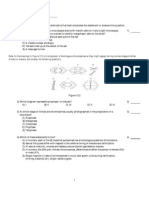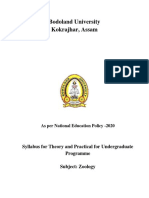0 ratings0% found this document useful (0 votes)
79 views(5.2) Meiosis and Genetic Variation
(5.2) Meiosis and Genetic Variation
Uploaded by
api-26229242Meiosis and genetic variation are summarized in 3 sentences:
Meiosis is a type of cell division that produces gametes with half the normal number of chromosomes, resulting from two nuclear divisions rather than one. During meiosis, homologous chromosomes pair up and may exchange portions through crossing over, resulting in genetic variation in offspring. Meiosis allows for sexual reproduction by fusing gametes during fertilization to form a diploid zygote with a full chromosome complement from each parent.
Copyright:
Attribution Non-Commercial (BY-NC)
Available Formats
Download as DOC, PDF, TXT or read online from Scribd
(5.2) Meiosis and Genetic Variation
(5.2) Meiosis and Genetic Variation
Uploaded by
api-262292420 ratings0% found this document useful (0 votes)
79 views1 pageMeiosis and genetic variation are summarized in 3 sentences:
Meiosis is a type of cell division that produces gametes with half the normal number of chromosomes, resulting from two nuclear divisions rather than one. During meiosis, homologous chromosomes pair up and may exchange portions through crossing over, resulting in genetic variation in offspring. Meiosis allows for sexual reproduction by fusing gametes during fertilization to form a diploid zygote with a full chromosome complement from each parent.
Original Title
null
Copyright
© Attribution Non-Commercial (BY-NC)
Available Formats
DOC, PDF, TXT or read online from Scribd
Share this document
Did you find this document useful?
Is this content inappropriate?
Meiosis and genetic variation are summarized in 3 sentences:
Meiosis is a type of cell division that produces gametes with half the normal number of chromosomes, resulting from two nuclear divisions rather than one. During meiosis, homologous chromosomes pair up and may exchange portions through crossing over, resulting in genetic variation in offspring. Meiosis allows for sexual reproduction by fusing gametes during fertilization to form a diploid zygote with a full chromosome complement from each parent.
Copyright:
Attribution Non-Commercial (BY-NC)
Available Formats
Download as DOC, PDF, TXT or read online from Scribd
Download as doc, pdf, or txt
0 ratings0% found this document useful (0 votes)
79 views1 page(5.2) Meiosis and Genetic Variation
(5.2) Meiosis and Genetic Variation
Uploaded by
api-26229242Meiosis and genetic variation are summarized in 3 sentences:
Meiosis is a type of cell division that produces gametes with half the normal number of chromosomes, resulting from two nuclear divisions rather than one. During meiosis, homologous chromosomes pair up and may exchange portions through crossing over, resulting in genetic variation in offspring. Meiosis allows for sexual reproduction by fusing gametes during fertilization to form a diploid zygote with a full chromosome complement from each parent.
Copyright:
Attribution Non-Commercial (BY-NC)
Available Formats
Download as DOC, PDF, TXT or read online from Scribd
Download as doc, pdf, or txt
You are on page 1of 1
(5.
2) MEIOSIS AND GENETIC VARIATION
(The letter before each clue is the first letter of the answer - write the answer in the space below each clue)
A. One of the different forms of a particular gene. (6) M. Name of the chromosomes contributed by the
mother. (8)
C. In the second division of meiosis, these have
moved apart. (10) M. Type of cell division which produces four daughter
cells each with half the chromosome number of
chromosomes as the parent cell. (7)
C/O. Describes the swapping over of portions of
chromatids in the first division of meiosis. (8,4)
M. Type of cell division which produces two daughter
nuclei with the same number of chromosomes as
the parent cell. (7)
D. Name given to the cells and nuclei which are
produced as a result of cell division. (8)
N/T. Number of chromosomes a human cell would
contain after fertilisation if the gametes had been
formed by mitosis rather than meiosis. if the (6,3)
D. Describes a cell which has a full set of
chromosomes. (7)
P. Name of the chromosomes contributed by the
father. (8)
F. Name given to the fusion of two gametes. (13)
R. Describes when the broken off portions of
G. Two of these fuse to give rise to a new offspring. chromatids recombine during crossing over. (13)
(7)
T/T. Number of chromosomes in a human haploid cell.
G. This is a section of DNA that codes for a (6,5)
polypeptide. (4)
T. Chromatids of homologous chromosome .....? .......
G/V. The various stages during meiosis all combine to around each other prior to crossing over. (5)
produce this in the offspring. (7,9)
T. Number of nuclear divisions involved in meiosis.
H. Is a cell with an uneven number of chromosomes (3)
likely to be haploid or diploid. (7)
L. This is the position of a gene on a chromosome. (5)
You might also like
- FINAL - CSEC Biology Lab Manual 2022-2024 STUDENT VERSIONDocument48 pagesFINAL - CSEC Biology Lab Manual 2022-2024 STUDENT VERSIONchristismithja100% (1)
- This Study Resource Was: Cell Division WorksheetDocument4 pagesThis Study Resource Was: Cell Division WorksheetMary Anne MosedeilNo ratings yet
- Mitosis Worksheet: Prophase Metaphase InterphaseDocument3 pagesMitosis Worksheet: Prophase Metaphase InterphaseChristopher John Sumilang100% (2)
- Cell Bio Final SOS PackageDocument51 pagesCell Bio Final SOS PackageMegadirectioner 21No ratings yet
- Mitosis and Meiosis WorksheetDocument4 pagesMitosis and Meiosis WorksheetAutumn Jackson-ButlerNo ratings yet
- CH 13 Guided Reading AP BioDocument4 pagesCH 13 Guided Reading AP BioKyle Schmidt50% (2)
- Meiosispacketanswer PDFDocument6 pagesMeiosispacketanswer PDFVictoria Afrianty BessieNo ratings yet
- Quiz2 Cell Reproduction BIO G8Document2 pagesQuiz2 Cell Reproduction BIO G8JC AlcantaraNo ratings yet
- Cell Division ActivityDocument4 pagesCell Division ActivityVivaMapwaNo ratings yet
- Class XII Biology Summer Vacation WorksheetDocument4 pagesClass XII Biology Summer Vacation WorksheetMansi DubeyNo ratings yet
- (2.2) Structure of DnaDocument1 page(2.2) Structure of Dnaapi-26229242No ratings yet
- MEIOSIS WorksheetDocument8 pagesMEIOSIS WorksheetEliseo PamandananNo ratings yet
- Meiosis Worksheet - PearsonDocument3 pagesMeiosis Worksheet - PearsoneNo ratings yet
- 13 TestDocument153 pages13 TestWill WolskyNo ratings yet
- Cell CycleDocument1 pageCell Cyclenica onicaNo ratings yet
- Cell Division Worksheet studentDocument4 pagesCell Division Worksheet studentprarthu2504No ratings yet
- 1936 FdocDocument12 pages1936 FdocNicoleNo ratings yet
- Section A Questions On Cell Continuity Higher Level: SEC Sample Paper HL 1Document7 pagesSection A Questions On Cell Continuity Higher Level: SEC Sample Paper HL 1ROVER DECENA SALINAS100% (1)
- MULTIPLE CHOICE. Choose The One Alternative That Best Completes The Statement or Answers The QuestionDocument19 pagesMULTIPLE CHOICE. Choose The One Alternative That Best Completes The Statement or Answers The Questionkavianr0% (1)
- Mr. Snider AP Biology Mitosis and Genetics Test 1 SocesDocument7 pagesMr. Snider AP Biology Mitosis and Genetics Test 1 SocesddNo ratings yet
- Mito-Meiosis Test AnswersDocument11 pagesMito-Meiosis Test Answersrosidin_551390No ratings yet
- Important QuestionsDocument5 pagesImportant Questionscomputerproject6251No ratings yet
- Taller Ciclo CelularDocument6 pagesTaller Ciclo CelularJ. Yesid Sierra PlataNo ratings yet
- CELL DIVISION Q and ADocument2 pagesCELL DIVISION Q and AMariah CampbellNo ratings yet
- Cell Divsion QuestionsDocument2 pagesCell Divsion Questionsrajpoot bhattiNo ratings yet
- 11.cell Division and Cell Cycle - RyanDocument9 pages11.cell Division and Cell Cycle - RyanTatyan YauNo ratings yet
- 1.3 Continuity Ans PDFDocument3 pages1.3 Continuity Ans PDFtess_15No ratings yet
- Cell Division Descriptive TypesDocument2 pagesCell Division Descriptive Typesayushmanc67No ratings yet
- Homework 1Document4 pagesHomework 1ButterlesstoastNo ratings yet
- 1406 Self Quiz ch12Document3 pages1406 Self Quiz ch12scdantolino100% (1)
- Assignment-1 Genetics 341Document4 pagesAssignment-1 Genetics 341damionsimmons10No ratings yet
- Practice Review Questions - Around The RoomDocument4 pagesPractice Review Questions - Around The RoomTA - 07KL 753815 Balmoral Drive Sr PSNo ratings yet
- Chapter 12Document40 pagesChapter 12Sathish KumarNo ratings yet
- AP Bio Chapter 13 Meiosis, Mel Bio 17, Mel Bio 16Document32 pagesAP Bio Chapter 13 Meiosis, Mel Bio 17, Mel Bio 16EUNAH LimNo ratings yet
- Cell Divsion QuestionsDocument2 pagesCell Divsion QuestionsDorothy MelodyNo ratings yet
- Readings Ch04Document11 pagesReadings Ch04Adrian GuzmanNo ratings yet
- BIO SOL Review 13 - Reproduction - Mitosis, MeiosisDocument4 pagesBIO SOL Review 13 - Reproduction - Mitosis, MeiosisJack DalrympleNo ratings yet
- Meiosis and Practice QuestionDocument8 pagesMeiosis and Practice Questionfekade.0935No ratings yet
- Mitosis and Meiosis Study Guide KEYDocument8 pagesMitosis and Meiosis Study Guide KEYrodneyperuNo ratings yet
- Ebookfiles 5825Document33 pagesEbookfiles 5825aledarelevanc669No ratings yet
- Genetics QsDocument5 pagesGenetics QsjawaNo ratings yet
- SolutionsCh1 6Document49 pagesSolutionsCh1 6kyo.sohma13thNo ratings yet
- Cell Cycle and Cell Division Practice PaperDocument5 pagesCell Cycle and Cell Division Practice Paperkamalikac545No ratings yet
- Quiz Mitosis Meiosis OnlineDocument3 pagesQuiz Mitosis Meiosis OnlineGabby SalazarNo ratings yet
- Cell Division AnswersDocument1 pageCell Division AnswersLaiyee ChanNo ratings yet
- Sci.8 4th Term - Test QuestionnaireDocument3 pagesSci.8 4th Term - Test QuestionnaireJENIVIEVE DELARMENTENo ratings yet
- Class 10 Biology WS 2pdfDocument5 pagesClass 10 Biology WS 2pdfks2425220No ratings yet
- Grade 9 Biology Final-Term Study Guide 2021-2022Document12 pagesGrade 9 Biology Final-Term Study Guide 2021-2022Ahmad AlabdulhadiNo ratings yet
- Short QuizDocument2 pagesShort Quizhidielyn gammadNo ratings yet
- Xcomparing Mitosis & MeiosisDocument2 pagesXcomparing Mitosis & MeiosisPandesal with EggNo ratings yet
- Homework 1 AnswersDocument8 pagesHomework 1 AnswersButterlesstoastNo ratings yet
- Revision 9 1 Biology 3 TDocument6 pagesRevision 9 1 Biology 3 Tmohamed mosadNo ratings yet
- Test of Bio Class 9th Al-Noor 92Document1 pageTest of Bio Class 9th Al-Noor 92karan lalNo ratings yet
- Heredity and VariationDocument79 pagesHeredity and VariationNathiya100% (2)
- Worksheet On GeneticsDocument12 pagesWorksheet On GeneticsjustusepannaNo ratings yet
- TestDaily分享 markscheme SL paper2Document54 pagesTestDaily分享 markscheme SL paper2gary gazaNo ratings yet
- Cell Division.Document13 pagesCell Division.XONo ratings yet
- A Sjfhlkaj HSFDocument9 pagesA Sjfhlkaj HSFxinyi.huang3No ratings yet
- Genetics PDFDocument37 pagesGenetics PDFpranalinshahNo ratings yet
- SR 1 CH 5 Cell Division 2024 AnswerDocument10 pagesSR 1 CH 5 Cell Division 2024 Answerlem.seng0310No ratings yet
- Topical Guidebook For GCE O Level Biology 3 Part 2From EverandTopical Guidebook For GCE O Level Biology 3 Part 2Rating: 5 out of 5 stars5/5 (1)
- Genes and AllelesDocument23 pagesGenes and Allelesapi-26229242No ratings yet
- Inherited and Environmental Variation VariationDocument2 pagesInherited and Environmental Variation Variationapi-26229242No ratings yet
- Treatment For Genetic Disorders Using Techniques That Replace or Supplement The Defective GeneDocument19 pagesTreatment For Genetic Disorders Using Techniques That Replace or Supplement The Defective Geneapi-26229242No ratings yet
- Revision Questions For Units 1 and 2: Unit 1Document7 pagesRevision Questions For Units 1 and 2: Unit 1api-26229242No ratings yet
- Meiosis & Sexual ReproductionDocument4 pagesMeiosis & Sexual ReproductionJazmine TriaNo ratings yet
- BSC Zoology M Sem 4 Paper M 4.2 2015Document3 pagesBSC Zoology M Sem 4 Paper M 4.2 2015Let's KnowNo ratings yet
- Molecular Biology Fourth Edition Chapt01 LectureDocument18 pagesMolecular Biology Fourth Edition Chapt01 LecturePandit JiNo ratings yet
- Module 2 Week 2Document13 pagesModule 2 Week 2janezpersonalzNo ratings yet
- Chromosomal Evolution: Genes Are Found On ChromosomesDocument28 pagesChromosomal Evolution: Genes Are Found On ChromosomesDibbyangana MukherjeeNo ratings yet
- DNA RecombinationDocument25 pagesDNA RecombinationNedhal Mahmoud KaleefahNo ratings yet
- 2018F BIO152H5F Midterm Examination Version A Oct 23Document9 pages2018F BIO152H5F Midterm Examination Version A Oct 23mrkevinpereiraNo ratings yet
- History of BiotechnologyDocument96 pagesHistory of BiotechnologyeskaNo ratings yet
- Biology PPT Group 5Document15 pagesBiology PPT Group 5Air ConditionerNo ratings yet
- Worksheet 10.1: Chapter 10: Genetics 2 - Fifteen Summary FactsDocument2 pagesWorksheet 10.1: Chapter 10: Genetics 2 - Fifteen Summary FactsRabia RafiqueNo ratings yet
- QP 202001 Biology U1Document28 pagesQP 202001 Biology U1张查No ratings yet
- Genetic Linkage: Presented By:ayush Jain (Alm 3008) University of Agricultural Science, BangloreDocument32 pagesGenetic Linkage: Presented By:ayush Jain (Alm 3008) University of Agricultural Science, BangloreTeflon SlimNo ratings yet
- 4.2 Deviations From The Mendelian InheritanceDocument62 pages4.2 Deviations From The Mendelian InheritancejiaenNo ratings yet
- New Microsoft Word DocumentDocument4 pagesNew Microsoft Word DocumentGina Portuguese GawonNo ratings yet
- Xiang Xiang Li - MeiosisSEDocument8 pagesXiang Xiang Li - MeiosisSEXiang Xiang Li100% (1)
- Bio2 11 - 12 Q3 0402 PF FDDocument38 pagesBio2 11 - 12 Q3 0402 PF FDLindsay SicatNo ratings yet
- Genomes and Their EvolutionDocument23 pagesGenomes and Their Evolutionprehealthhelp100% (2)
- McatDocument50 pagesMcatbebbuwebbuNo ratings yet
- QUIZ#5 GeneticsDocument6 pagesQUIZ#5 GeneticsLouiza Angelina LayugNo ratings yet
- How To Use DNA Baser - 2 Minutes Video Tutorial - UrlDocument13 pagesHow To Use DNA Baser - 2 Minutes Video Tutorial - UrlThanga DuraiNo ratings yet
- Biology Form 5 Chapter 6 VariationDocument5 pagesBiology Form 5 Chapter 6 VariationFendy HamidNo ratings yet
- Zoology NEP SyllabusDocument88 pagesZoology NEP SyllabusBobby BhattacharjeeNo ratings yet
- GENBIO1 - Q1 - MOD8 OF 8 - Mitosis.Document25 pagesGENBIO1 - Q1 - MOD8 OF 8 - Mitosis.Warlin FernandezNo ratings yet
- Tautomeric ShiftDocument4 pagesTautomeric ShiftTonmoy SarkerNo ratings yet
- 4 Mapping in EukaryotesDocument36 pages4 Mapping in EukaryotesSabesan TNo ratings yet
- Combinepdf 7Document129 pagesCombinepdf 7Joe JosephNo ratings yet
- CBCS BSC Zoology Sem III Sem IV 08192023161617Document11 pagesCBCS BSC Zoology Sem III Sem IV 08192023161617nadimshah890No ratings yet
- Official GR 12 June 2024 Life Sciences Marking Guideline EngDocument14 pagesOfficial GR 12 June 2024 Life Sciences Marking Guideline Engmamburuinnocentia1No ratings yet





























































































